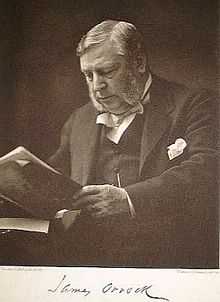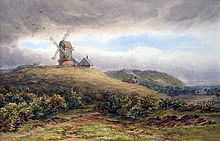James Orrock
| James Orrock RI | |
|---|---|
 James Orrock | |
| Born |
1829 Edinburgh, Scotland |
| Died |
May 10, 1913 (aged 84) Shepperton, Middlesex, England |
| Nationality | Scottish |
| Field | Watercolour Landscape |
| Training |
James Ferguson William L. Leitch John Burgess |
| Alma mater | Nottingham School of Design under Thomas Stuart Smith |
| Awards |
Royal Institute of Painters in Watercolours Royal Scottish Academy Royal Academy |

James Orrock RI (1829 – 10 May 1913), was a prominent Scottish collector of art and oriental ceramics, illustrator and landscape watercolourist. Today, he is also considered as the main source of forgeries from the later 19th century, associated with copies of the works of John Constable.[1][2][3]
The son of an Edinburgh dentist, he was himself educated in medicine, surgery, and dentistry at Edinburgh University, after which he practised as a dentist in Nottingham. Orrock studied painting under James Ferguson, William L. Leitch, and John Burgess, later enrolling at the Nottingham School of Design where he was taught by Thomas Stuart Smith.
He settled in London by 1866, becoming an associate of the Royal Institute of Painters in Water Colours in 1871, exhibiting at the Royal Scottish Academy and Royal Academy. His later style was highly influeced by David Cox, his paintings today are on show in various museums and galleries, including the Victoria and Albert Museum.[4]
A strong advocate of J. M. W. Turner and British art in general, he was a renowned collector of paintings and oriental ceramics. A landscape painter and watercolourist, he is now believed to have and is thought to restored, altered and improved works by other painters within his collection. Orrock created art-period rooms in his house, which he opened to the general public.[5]
Having on two previous occasions bought furniture and paintings from Orrock's personal collection,[1] on Orrock's death Lord Leverhulme bought most of his art collection, and some one thousand of his own paintings. Part of that collection was used to create the Lady Lever Art Gallery at Port Sunlight.[6][7][8][9][10][11] It was later confirmed that two watercolours by Cox bought by Leverhulme from Orrock were in forgeries.[1]
Today, Orrock is also notable as being the commissioner - but probably not the actual artist forger - of many of the forgeries associated to the works of John Constable.[2][3] His association with one copy of A Sea Beach Brighton painting by Constable was featured on the BBC One's Fake or Fortune? in January 2014.[12]
References
- ↑ 1.0 1.1 1.2 "Lever and James Orrock". Lady Lever Art Gallery. Retrieved 25 January 2014.
- ↑ 2.0 2.1 Charles S. Rhyne (17 February 1994). "Deaccessioning John Constable: The Complexity of Authenticity". Reed College. Retrieved 25 January 2014.
- ↑ 3.0 3.1 "North East could solve riddle of lost Blake collection". University of Manchester. 26 October 2011. Retrieved 25 January 2014.
- ↑ "A Hayfield in Surrey by James Orrock". Victoria and Albert Museum. Retrieved 25 January 2014.
- ↑ "James Orrock, 1829-1913". University of Glasgow. Retrieved 25 January 2014.
- ↑ "Art Collection". Kevindaniel.250x.com. Retrieved 2010-05-18.
- ↑ "For Exceptional Art. James Orrock". Artlands. Retrieved 2010-05-18.
- ↑ "Connosseurship". Jmwturner.ca. Retrieved 2010-05-18.
- ↑ "20th-Century Scottish Illustrators - Rare Books Collections - National Library of Scotland". Nls.uk. Retrieved 2010-05-18.
- ↑ Obituary, Evening Post, Volume LXXXV, Issue 114, 15 May 1913, Page 7
- ↑ "Powered by Google Docs". Docs.google.com. Retrieved 2010-05-18.
- ↑ BBC One Fake or Fortune episode 2/4, broadcast 26 January 2014
External links
| Wikimedia Commons has media related to James Orrock. |
|